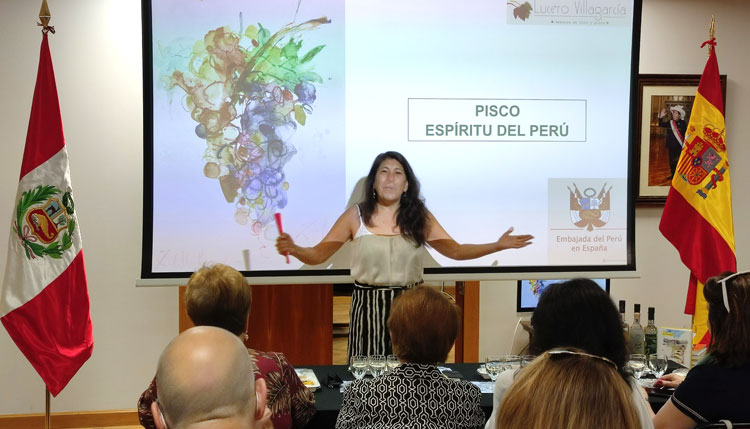Juan David Latorre
The Embassy of Peru organized last Monday a Pisco Tasting with the renowned Peruvian sommelier Lucero Villagarcía, who explained the history of Pisco and its elaboration, the characteristics of the Pisco grapes, a brief overview of the Pisco regions and their wineries, culminating with the tasting of four different Pisco grapes from four different regions of Peru.
The event was aimed at owners and chefs of Peruvian-Spanish and Spanish fusion restaurants that include traditional dishes from the South American country in their menus, as well as renowned local sommeliers and gastronomic press.
Pisco is the product obtained exclusively by distillation of fresh musts from recently fermented “Pisque grapes”, using methods that maintain the traditional principles of quality. Called the vapour of wine or the spirit of wine, pisco is colourless and transparent. It is part of Peru’s idiosyncrasy, part of everyday life, part of family gatherings and very important in the Peruvian economy, as there are currently 525 producers in the country and only 8 of them are industries, which reflects the number of small producers and families that live from its production.
There are five regions in Peru where pisco is produced, the departments of Lima, Ica, Arequipa, Moquegua and the valleys of Locumba, Sama and Caplina in the department of Tacna, and each of them produces a different pisco. It is harvested in March and must rest for six months.
There are three types of pisco: pure, green must and acholado. Hernando de Montenegro was the first wine producer. He was the first person to plant vineyards in Lima between 1539 and mid-1541. Plants were taken from his vineyard for planting in other lands in this city, as well as in Ica, Huamanga, Cuzco, Arequipa and Chile, as it was a vineyard with a good vineyard. Ica had rich clay mines, large forests of huarangos and copper mines to make the pots where they cooked the broths and extracted the grape brandy, which they later called pisco.
In the register of the ship Nuestra Señora de la Soledad in Acapulco in 1712, the expressions “aguardiente de pisco” and “botijas de aguardiente de pisco” were used to refer to the Peruvian drink that was exported to the ports of Mexico and Central America. This record is the first reference outside Peru so far to the use of this name for this ‘spirit of wine’.







